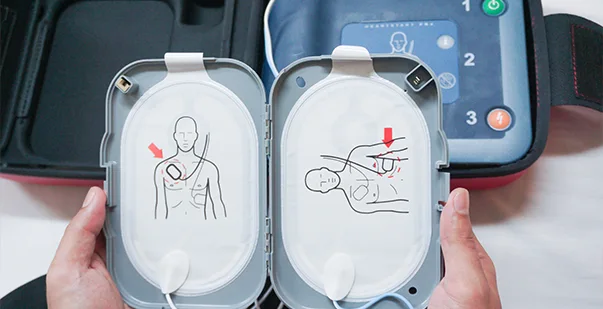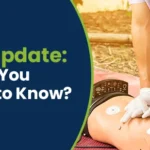Table of Contents:
- Introduction
- Understanding the AED Device
- Importance of Proper AED Pad Placement for Adults
- A Detailed View on Proper AED Pad Placement for Adults
- AED Pads Placement for Specific Populations
- Precautionary Measures for AED Pad Placement
- Understand the Proper Placement to Save Lives
Have you find yourself in an emergency situation where you need to save a life with AED? In the event of sudden cardiac arrest (SCA), the heart is unable to pump the blood required by the vital organs of the body. Whether you are an EMT or certified bystanders, you must use an AED device to shock the heart with adequate current, interrupting the irregular activity and allowing the heart to resume a healthy cardiac rhythm.
In fact, the chances of survival for SCA victims decrease by 7-10% every minute without an AED shock. It is most effective when administered within the first three minutes of cardiac arrest.However to reap the fullest potential, you should know the proper AED pad placement for adults. Read on to get more valuable insights to maximize the life-saving potential of the device!
Master ACLS Now
Get ACLS certified with confidence
Understanding the AED device
An AED (Automated External Defibrillator) is a life-saving device that provides electrical shocks to people experiencing sudden cardiac arrest. One of the crucial aspects of using an AED pad placement which ensures effective delivery of a shock to the heart. The need for an emergency response can occur anytime. Hence, airports, business centers, office buildings, educational institutions, shopping malls, and public buildings have already installed AED units on their premises and provided CPR training for their staff.
Importance of Proper AED Pad Placement for Adults
Proper AED pad placement for adults is vital for the success of the defibrillation process, which can influence the outcome and ultimately save the victim’s life. Incorrect positioning of the pads can have severe complications and compromise the effectiveness of the life-saving technique. Here are some critical reasons highlighting the importance of proper AED pad placement:
Efficiency
The AED machine must efficiently deliver the electric shock to the heart. Therefore, the AED pads should be properly placed to analyze the victim’s heart rhythm accurately and deliver an adequate shock. If the pads are not in the right position, the AED may not be able to detect the heart rhythm or deliver an effective shock, leading to the failure of the defibrillation process and potentially the loss of life.
Safety
If the pads are not placed properly, it might cause severe harm to the victim or the rescuer using the AED device. For instance, the pads should not be placed over any metal objects or wet areas on the victim’s body, which might lead to severe injury. To mitigate such risks, it is important to have a comprehensive understanding of proper AED pad placement. Regular training helps ensure that AEDs are correctly used in emergencies.
Timely Treatment
During cardiac arrest episodes, every second matters. Learning the proper placement of AED pads helps avoid delays in delivering life-saving treatment. Properly placed pads enable the device to assess the heart rhythm quickly and prompt the rescuer to deliver shocks when required, thereby improving the chances of successful resuscitation.
A Detailed View on Proper AED Pad Placement for Adults
AED pad placement is a critical step toward the effective use of the device; any incorrect positioning will affect the effectiveness of the electrical shock and reduce the survival rate of the victim. Here’s an overview of the proper placement of AED pads in different positions:
Anterior-Lateral Position
Anterolateral placement of AED pads is considered the standard AED position, followed in most AED units. In this position, two pads are included in the kit. One AED pad is positioned on the upper right side of the chest, just below the collarbone, while the other is placed on the lower left side of the chest, just below the ribcage. Here are the steps for the procedure:
- Step 1: Expose the victim’s chest by removing any type of clothing or other obstructions to ensure there is nothing between the AED device and the skin.
- Step 2: Connect the AED pads to the cables and gently remove the safety backing from each pad’s adhesive part.
- Step 3: Ensure the anterolateral pad placement is secured on the upper right side of the chest and the other on the lower left side of the chest. Ensure the pads are centered on the chest with no objects in between.
Anterior-Posterior Position
In some AED units, technicians might use a different automated external defibrillator pad placement known as the anterior-posterior position. This position involves placing one pad on the patient’s back between the shoulder blades and the other pad on the front of the victim’s chest.
Whatever type of AED pad placement for adults you choose, remember to follow the specific prompts and instructions mentioned in the device. Pad position requirements might vary slightly depending on the device being used. Understanding and familiarizing yourself with the user’s manual before using the device is essential to avoid any errors.
AED Pads Placement for Different Situations
While AED devices are designed to be user-friendly and effective across different ages and populations. Here are some pointers to keep in mind to deliver the best possible cardiac care for specific adult populations.
AED Placement for Pregnant Women
AED placement on a woman who is pregnant should be planned based on the safety of both the mother and the fetus. The AED pad placements should be in the standard position on the chest while avoiding the abdomen. In certain circumstances, trained healthcare professionals manually displace the uterus to the left side to reduce interference caused by the AED pads. It is also important to remember that pregnant women require different CPR techniques due to changes in their body’s anatomy and physiology.
AED Placement for Elderly People
Elderly people also have certain considerations regarding the AED pad position. Due to their skin condition, which may be excessively thin or fragile, they need extra care during pad placement to ensure good adhesion. Additionally, they might have underlying health conditions that could affect the effectiveness of CPR and defibrillation. Make sure to properly adjust the device to provide appropriate pressure during chest compressions and increase their chances of survival.
AED Placement for Cardiac Arrest Victims with Pacemaker
Pacemakers regulate heartbeats when they detect any signs of arrhythmia. However, learning the AED pad placement with a pacemaker is crucial as the device may not respond to regular ventricular fibrillation. To identify if the cardiac arrest victim has a pacemaker, look for a small bulge on the upper chest or abdominal region.
If the victim has a pacemaker or an implantable cardioverter-defibrillator (ICD), position the AED pad four fingers away from the device.
Precautionary Measures for AED Pad Placement
When attaching AED pads to the victim’s body, it is important to follow some preventive measures to ensure optimal contact and the technique’s effectiveness. Here’s a comprehensive list of safety precautions for proper AED pad placement.
General Precaution
Automated external defibrillator devices are designed to deliver electric shocks in essential situations and are considered safe to use. The device assesses the rhythm of the heart and determines if an electric shock is needed. If the AED predicts a shock is required, it will inform the rescuer to stand clear before delivering the shock. While using the device, it is important to follow such prompts to ensure no one comes in contact with the victim when the shock is delivered for first aid emergency response.
Metal Surface
During AED pad placement, ensure the victim is not in contact with any metal surfaces, as they might conduct electrical shocks to the rescuer or victim, posing a hazard. This includes metallic jewelry, which should be immediately moved away from the AED pads and to the side of the chest. If left unnoticed, it could cause sparks and burns to the chest when delivering the AED shock.
Wet Surfaces and Water
Water is an electrical conductor; hence, exposure to sweat, moisture, water, or any wet surface during the AED procedure creates a risk for both the victim and the rescuer. Before taking the correct AED pad position, ensure the victim is placed in a dry spot. Wipe their chest clean and dry before attaching the AED electrode pads. Most AED units include a small towel to address these potential issues. Moreover, moisture on the chest will reduce the pad adhesion to the chest wall and ultimately affect effectiveness.
Transdermal Patch
AED pads should not be placed over transdermal or medicated patches, as this might cause burns during AED electric shocks. Therefore, make sure to remove the transdermal patches from the victim’s chest before starting the AED procedure.
Understand the Proper Placement to Save Lives
AEDs are life-saving devices for individuals experiencing sudden cardiac arrest. They deliver electric shocks as a first aid emergency response before the arrival of professional medical services. AEDs are easy to use, affordable, and accessible, making them essential tools in public spaces. Learning proper AED pad placement for adults is key to achieving the effectiveness of the treatment and increasing survival rates. Following the guidelines for pad placement ensures the uninterrupted delivery of precise and timely shocks to restore a normal, healthy rhythm.







